Apologies for the lateness of this wrap-up - I didn't want to interfere with the Graphics Test Week posts on my blog! A Graphics Test Week wrap-up should be coming tomorrow.
Indeed like many others at RH and in the Fedora community, I was at FUDCon Zurich last month. First I'd like to say thanks again to Sandro and Marcus for their amazing job of organizing the event - everything went off smoothly and they even contrived to have enough money left over in the budget to beat out the legendary Czech alcohol tolerance at FUDPub. Incredible!
Note that all the pictures in this post are courtesy of Máirín, as I stupidly forgot my camera. Thanks Mo!
I arrived early the day before the conference, got myself set up at the hotel (which was excellent, and had a scarily fast internet connection), and did some Beta release process work. After a while, I heard that Jared, Jesse, Spot and Mo were at the hotel, so we got together and went out for fondue. Really very nice fondue. Bert happened by the restaurant while we were eating and joined us, and we chatted very seriously and exclusively about important, work-related topics. There were *definitely* no anecdotes about NASA. (That was for the benefit of Jared's expense report).
 After the fondue, we went to the venue and got in the way of - I mean, assisted in - setting up the hall for FROSCamp. I started off plugging in routers but my QA genes took over and I wound up testing connectivity by running round the hall and plugging my laptop into each one in turn...
After that we headed back to the hotel. The others made it successfully back to their rooms, but I was snared in the hotel bar by Jeroen and Peter Robinson (and also Xavier and a few others, but once you have Jeroen, me and Peter at a table, no-one else gets a word in edgeways for four hours). Peter being Australian and me being an adopted Canadian, whenever we meet up we always wind up having a beer or eight and sticking the knife into the whinging Poms (that's the English, for my American readers...), and Jeroen's always pleased to have an audience, so I didn't manage to stagger up to my room to write my talk for the next morning until several hours and several beers later.
This of course had absolutely no impact on my stunningly professional and captivating delivery of my talk the next morning. Actually, I didn't change the talk much from the last time I gave it, at FUDCon Toronto; I should really give it a more thorough rewrite and make it look snazzier, I was a bit disappointed at how many things I remembered during the talk I should be covering and wasn't. But it seemed like most people watching managed to stay awake, I kept it short, and some people signed up as proven testers after it was finished, so I don't think it was a complete disaster! The talk is a general overview of the Fedora QA team's tasks and processes and how to get involved in them, I certainly encourage anyone who's involved in QA and going to an event to propose a similar talk, and please use any material from my slides that might be useful.
I read that some people felt the talks were a bit disappointing, but I was pretty happy with the ones I went to. On the first day I dropped in on Spot's packaging workshop, which I thought he did really well, and which seemed popular. I also sat in on the release engineering SOP workshop, and helped Jesse out with a few things, but mostly sat there and worked on Beta testing.
On the second day I went to Kamil's AutoQA overview talk, which was impressively detailed and smoothly run. It sparked some passionate audience debate and feedback, too, which always means you're on the right track! Kamil did a great job of explaining both how the AutoQA project is structured and being developed, and the value it will provide for Fedora. I also went to Jesse's talk on the new git-based RCS for Fedora packages, which covered a lot of ground I'd more or less come to terms with already but also gave me a few useful new tips, and must have been invaluable for anyone who hadn't figured out the new system yet. I also saw Spot's talk on legal issues surrounding Fedora, especially Fedora packaging, which was informative and amusing in the way only Spot can manage. I highly recommend anyone involved in packaging go to one of Spot's presentations, or just corner Spot and let him tell you legal anecdotes for a few hours; you'll come out a lot better informed and a lot more cautious about licensing, patent and trademark issues. I also went to Jared's talk on VoIP, but wound up working through most of it! I spent most of the weekend juggling conference stuff with the F14 Beta validation process, you'll probably have noticed by now.
FUDPub was the evening of the second day, and it went very well - we went to a local pizza restaurant, but didn't get pizza. Instead the vegetarians got a sort of cheesy-vegetabley-potato-ey bake-y thing, which sounded worryingly vague but turned out to be delicious. I sat with most of the North American RHers, Peter, and Xavier, and we had a good time reminiscing. Or rather, the others reminisced and I pretended to have been around at the time...
On the final workshop day, I ran a workshop to do some desktop validation testing on the Beta - RC2 at the time. The turnout wasn't huge, but those who showed up - especially the awesome Christoph Wickert - really helped check out the state of the non-GNOME desktops. We managed to turn up some significant bugs in the LXDE and Xfce desktops which we eventually resolved in time for the Beta release, which was a great result.
Of the other workshops, I went to Peter's workshop on Fedora Mini and Sugar, which was very productive in terms of getting a bunch of people with an interest in Sugar, Moblin/Meego and the importance of getting Fedora onto non-boring-Intel-desktop-y-machines in general together and with a vaguely cohesive sense of purpose. We also renamed Fedora Mini to Fedora Mobility during the workshop, which was cool. I'm hoping to be able to help with making sure Sugar is in great condition for Fedora 14, and getting Meego in shape - hopefully we'll have something at least usable in Fedora 14, but we're mainly targeting Fedora 15 given the timeframes involved. Personally I think Meego in particular is much more significant than a lot of people realize yet, and I really hope we get it to the state where we can have a 'showcase platform' for Fedora 15 - some kind of handset or tablet - where you can stick in a Fedora USB stick (or SD card or whatever) and have it boot up into a fully-working, shiny, Fedora-ified Meego environment. That would be a great thing to be able to show people. It would also be good to let people have the Meego netbook UX right out of the box with Fedora.
I also caught half of Máirín's incredible Awesome Art Stuff workshop, which is basically two hours of Máirín demonstrating how to do insanely cool stuff in the GIMP (and other free art tools). If you've never been to one of these, you really really really should. No matter who you are. If you've ever dabbled in the GIMP even vaguely, or even wanted to but been too scared, you will learn a ton of stuff (and have even more stuff whiz by too fast to take in yet). Even if you've never touched the GIMP and never want to, it functions as awesome entertainment just to watch a badly-lit mugshot turn into a pristine hackergotchi, or a shiny shiny pony emerge fully-formed from the ether, or a scary-yet-cute dragon guy be dreamed up Live On Stage. It's just great.
Finally I went to Jared's Getting Connected To Fedora Talk workshop, which went off exactly as advertised. Actually I'm already connected to Fedora Talk, but we got everyone else there connected too, and did some test calls. We did find out that Fedora Talk can't really manage video well yet, as there's no protocol that the clients we tried and the Asterisk-powered server end can agree on. That's a shame. It'd be nice to fix it.
So all the formal events that were part of the conference were great, but as usual, probably even more valuable was just being able to meet people and work in real time. Having Hans de Goede and Jesse around in meatspace certainly helped resolve some issues and get all the F14 Beta blockers fixed in time for the Beta to ship, and having Christoph around let us get the desktop spins fixed up properly. Meeting Jeroen and Bert and Xavier and Sandro and dozens of others was great, and just being able to chat face-to-face about various little issues really helps to smooth them out. And I spent most of the event hanging around with Peter - as well as a deep mutual interest in drinking beer and complaining about the English, we talked a lot about Sugar and Meego and I came out with a strong sense of the importance of those projects and an enthusiasm for integrating them into the QA process. I'm hoping to get Sugar into the desktop validation process for Fedora 14 final and Meego integrated for Fedora 15, and I'd be really happy if we could.
I also wound up sharing my hotel room with Dave Crossland, who does font stuff for Google and volunteers on font and design stuff for Fedora, and survives on less sleep than any other human being I've ever met - I was doing eight hours of conference and twelve hours of F14 Beta validation per day, but he still managed to sleep eight hours after me every day and wake up enthusiastic in the morning. (No, don't do the math on that, please). He's also cheery and optimistic and has grand, entrepreneurial plans - it's like he's not really English at all.
After the fondue, we went to the venue and got in the way of - I mean, assisted in - setting up the hall for FROSCamp. I started off plugging in routers but my QA genes took over and I wound up testing connectivity by running round the hall and plugging my laptop into each one in turn...
After that we headed back to the hotel. The others made it successfully back to their rooms, but I was snared in the hotel bar by Jeroen and Peter Robinson (and also Xavier and a few others, but once you have Jeroen, me and Peter at a table, no-one else gets a word in edgeways for four hours). Peter being Australian and me being an adopted Canadian, whenever we meet up we always wind up having a beer or eight and sticking the knife into the whinging Poms (that's the English, for my American readers...), and Jeroen's always pleased to have an audience, so I didn't manage to stagger up to my room to write my talk for the next morning until several hours and several beers later.
This of course had absolutely no impact on my stunningly professional and captivating delivery of my talk the next morning. Actually, I didn't change the talk much from the last time I gave it, at FUDCon Toronto; I should really give it a more thorough rewrite and make it look snazzier, I was a bit disappointed at how many things I remembered during the talk I should be covering and wasn't. But it seemed like most people watching managed to stay awake, I kept it short, and some people signed up as proven testers after it was finished, so I don't think it was a complete disaster! The talk is a general overview of the Fedora QA team's tasks and processes and how to get involved in them, I certainly encourage anyone who's involved in QA and going to an event to propose a similar talk, and please use any material from my slides that might be useful.
I read that some people felt the talks were a bit disappointing, but I was pretty happy with the ones I went to. On the first day I dropped in on Spot's packaging workshop, which I thought he did really well, and which seemed popular. I also sat in on the release engineering SOP workshop, and helped Jesse out with a few things, but mostly sat there and worked on Beta testing.
On the second day I went to Kamil's AutoQA overview talk, which was impressively detailed and smoothly run. It sparked some passionate audience debate and feedback, too, which always means you're on the right track! Kamil did a great job of explaining both how the AutoQA project is structured and being developed, and the value it will provide for Fedora. I also went to Jesse's talk on the new git-based RCS for Fedora packages, which covered a lot of ground I'd more or less come to terms with already but also gave me a few useful new tips, and must have been invaluable for anyone who hadn't figured out the new system yet. I also saw Spot's talk on legal issues surrounding Fedora, especially Fedora packaging, which was informative and amusing in the way only Spot can manage. I highly recommend anyone involved in packaging go to one of Spot's presentations, or just corner Spot and let him tell you legal anecdotes for a few hours; you'll come out a lot better informed and a lot more cautious about licensing, patent and trademark issues. I also went to Jared's talk on VoIP, but wound up working through most of it! I spent most of the weekend juggling conference stuff with the F14 Beta validation process, you'll probably have noticed by now.
FUDPub was the evening of the second day, and it went very well - we went to a local pizza restaurant, but didn't get pizza. Instead the vegetarians got a sort of cheesy-vegetabley-potato-ey bake-y thing, which sounded worryingly vague but turned out to be delicious. I sat with most of the North American RHers, Peter, and Xavier, and we had a good time reminiscing. Or rather, the others reminisced and I pretended to have been around at the time...
On the final workshop day, I ran a workshop to do some desktop validation testing on the Beta - RC2 at the time. The turnout wasn't huge, but those who showed up - especially the awesome Christoph Wickert - really helped check out the state of the non-GNOME desktops. We managed to turn up some significant bugs in the LXDE and Xfce desktops which we eventually resolved in time for the Beta release, which was a great result.
Of the other workshops, I went to Peter's workshop on Fedora Mini and Sugar, which was very productive in terms of getting a bunch of people with an interest in Sugar, Moblin/Meego and the importance of getting Fedora onto non-boring-Intel-desktop-y-machines in general together and with a vaguely cohesive sense of purpose. We also renamed Fedora Mini to Fedora Mobility during the workshop, which was cool. I'm hoping to be able to help with making sure Sugar is in great condition for Fedora 14, and getting Meego in shape - hopefully we'll have something at least usable in Fedora 14, but we're mainly targeting Fedora 15 given the timeframes involved. Personally I think Meego in particular is much more significant than a lot of people realize yet, and I really hope we get it to the state where we can have a 'showcase platform' for Fedora 15 - some kind of handset or tablet - where you can stick in a Fedora USB stick (or SD card or whatever) and have it boot up into a fully-working, shiny, Fedora-ified Meego environment. That would be a great thing to be able to show people. It would also be good to let people have the Meego netbook UX right out of the box with Fedora.
I also caught half of Máirín's incredible Awesome Art Stuff workshop, which is basically two hours of Máirín demonstrating how to do insanely cool stuff in the GIMP (and other free art tools). If you've never been to one of these, you really really really should. No matter who you are. If you've ever dabbled in the GIMP even vaguely, or even wanted to but been too scared, you will learn a ton of stuff (and have even more stuff whiz by too fast to take in yet). Even if you've never touched the GIMP and never want to, it functions as awesome entertainment just to watch a badly-lit mugshot turn into a pristine hackergotchi, or a shiny shiny pony emerge fully-formed from the ether, or a scary-yet-cute dragon guy be dreamed up Live On Stage. It's just great.
Finally I went to Jared's Getting Connected To Fedora Talk workshop, which went off exactly as advertised. Actually I'm already connected to Fedora Talk, but we got everyone else there connected too, and did some test calls. We did find out that Fedora Talk can't really manage video well yet, as there's no protocol that the clients we tried and the Asterisk-powered server end can agree on. That's a shame. It'd be nice to fix it.
So all the formal events that were part of the conference were great, but as usual, probably even more valuable was just being able to meet people and work in real time. Having Hans de Goede and Jesse around in meatspace certainly helped resolve some issues and get all the F14 Beta blockers fixed in time for the Beta to ship, and having Christoph around let us get the desktop spins fixed up properly. Meeting Jeroen and Bert and Xavier and Sandro and dozens of others was great, and just being able to chat face-to-face about various little issues really helps to smooth them out. And I spent most of the event hanging around with Peter - as well as a deep mutual interest in drinking beer and complaining about the English, we talked a lot about Sugar and Meego and I came out with a strong sense of the importance of those projects and an enthusiasm for integrating them into the QA process. I'm hoping to get Sugar into the desktop validation process for Fedora 14 final and Meego integrated for Fedora 15, and I'd be really happy if we could.
I also wound up sharing my hotel room with Dave Crossland, who does font stuff for Google and volunteers on font and design stuff for Fedora, and survives on less sleep than any other human being I've ever met - I was doing eight hours of conference and twelve hours of F14 Beta validation per day, but he still managed to sleep eight hours after me every day and wake up enthusiastic in the morning. (No, don't do the math on that, please). He's also cheery and optimistic and has grand, entrepreneurial plans - it's like he's not really English at all.
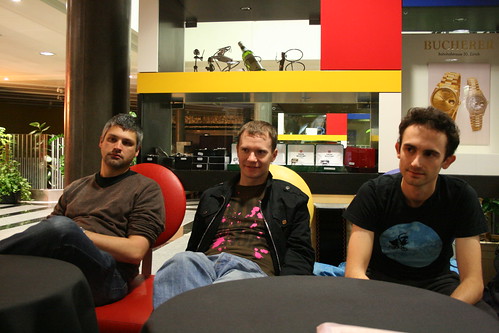 The Commonwealth - Peter, me, and Dave in the hotel lobby
So this was another enjoyable and valuable FUDCon. I'll be back at Tempe, hopefully with an all-new remixed QA Introduction 2.0 talk. And a unicorn. Probably just the talk, though.
The Commonwealth - Peter, me, and Dave in the hotel lobby
So this was another enjoyable and valuable FUDCon. I'll be back at Tempe, hopefully with an all-new remixed QA Introduction 2.0 talk. And a unicorn. Probably just the talk, though.

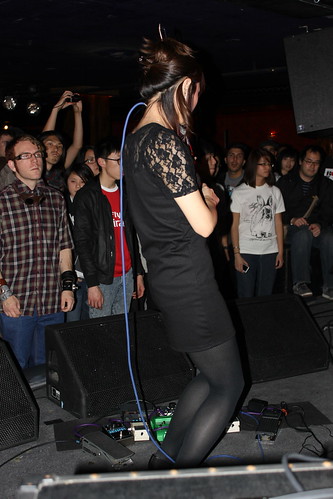

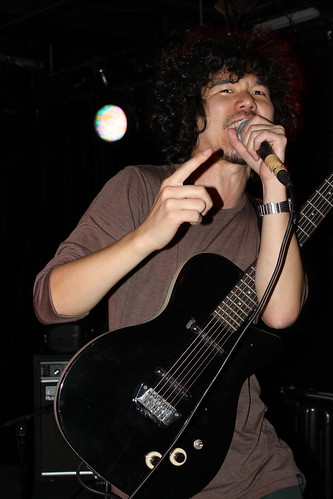
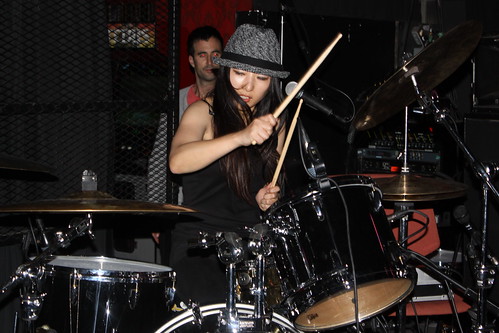
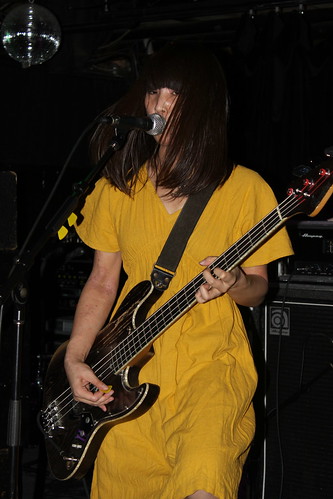


 After the fondue, we went to the venue and got in the way of - I mean, assisted in - setting up the hall for FROSCamp. I started off plugging in routers but my QA genes took over and I wound up testing connectivity by running round the hall and plugging my laptop into each one in turn...
After that we headed back to the hotel. The others made it successfully back to their rooms, but I was snared in the hotel bar by
After the fondue, we went to the venue and got in the way of - I mean, assisted in - setting up the hall for FROSCamp. I started off plugging in routers but my QA genes took over and I wound up testing connectivity by running round the hall and plugging my laptop into each one in turn...
After that we headed back to the hotel. The others made it successfully back to their rooms, but I was snared in the hotel bar by  The Commonwealth - Peter, me, and Dave in the hotel lobby
So this was another enjoyable and valuable FUDCon. I'll be back at
The Commonwealth - Peter, me, and Dave in the hotel lobby
So this was another enjoyable and valuable FUDCon. I'll be back at